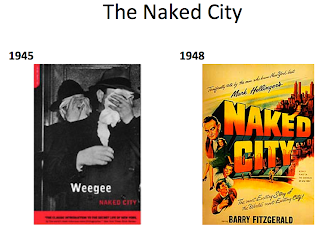Cities and Film Helen Clarke helen.clarke@leeds-art.ac.uk
The lecture looks as the city as represented on and in film: through both photography and in various film types (experimental silent cinema, contemporary video works, a Chaplin comedy, Film Noir and Cult Classics). In doing so it looks at the differences in the representation and theorization of urban existence in first Modernism and then Postmodernism.
This inevitably involves consideration of the body in the city. Beginning with Simmel, as the Frankfurt School do, the figure of the flaneur is explored in art, literature and in feminist theory.
To investigate or illustrate some of these ideas, the lecture offers readings of photographers like Sophie Calle, Joel Meyerwitz and Phillip Lorca di Corcia whose work can be critically investigated through theory.
Finally the lecture proposes a post Postmodern city where the body, the psyche and the city are intertwined by the threat (whether experienced or internalised) of terrorism. Lastly looking at how this may be represented through photography, film and video, the lecture considers Citizen Journalism as a visual response which democratises image making and starts to define the experience of the city.
We need to remember that photography established itself in a period when the growth of the city and industry had already provoked a formidable literature and art in response to the increasing influence of urban areas, especially cities such as London, Paris and New York. Photography takes it place in this process, but it does so in a consistently active sense, simultaneously responding to the variety and multiplicity of urban life and experience, and to the question s of how urban space was to be perceived and represented. In brief, its underlying response has been in relation to the visual complexity of a city as both an image and an experience.
(Clarke:1997: 75)Biblography •Cityscapes of modernity: critical explorations by David Frisby •Art of America: Modern Dreams (2/3) Andrew Grahame Dixon BBC 4 21/11/11 •De Grazia, Victoria (2005), Irresistible Empire: America's Advance Through 20th-Century Europe, Cambridge: Belknap Press of Harvard University Press •Susan Buck-Morss, The Dialectics of Seeing: Walter Benjamin and the Arcades Project (1989) •Grahame Clarke (1997) The Photograph, Chapter 5 The city in photography •http://hereisnewyork.org/ •Art in the Age of Terrorism, Terrible Beauties, Bernadette Buckley, (2005)
Fredrick Jameson Postmodernism, or, The Cultural Logic of Late Capitalism Verso, 1991
•The city in Modernism
•The possibility of an urban sociology
•The city as public and private space
•The city in Postmodernism
•The relation of the individual to the crowd in the city
Georg Simmel (1858-1018)
•German sociologist
•Writes Metropolis and Mental Life in 1903
•Influences critical theory of the Frankfurt School thinkers eg: Walter Benjamin, Kracauer, Adorno and Horkheimer
•Writes Metropolis and Mental Life in 1903
•Influences critical theory of the Frankfurt School thinkers eg: Walter Benjamin, Kracauer, Adorno and Horkheimer
Dresden Exhibition 1903
•Simmel is asked to lecture on the role of intellectual life in the city but instead reverses the idea and writes about the effect of the city on the individual
•Herbert Bayer Lonely Metropolitan 1932
•Herbert Bayer Lonely Metropolitan 1932
•the resistance of the individual to being levelled, swallowed up in the social-technological mechanism.
•— Georg Simmel The Metropolis and Mental Life 1903
•— Georg Simmel The Metropolis and Mental Life 1903
•creator of the modern skyscraper,
•an influential architect and critic of the Chicago School
•mentor to Frank Lloyd Wright,
•Guaranty Building was built in 1894 by Adler & Sullivan in Buffalo NY
Details from Guaranty Building
Manhatta (1921) Paul Strand and Charles Scheeler
Fordism: mechanised labour relations
•Coined by Antonio Gramsci in his essay "Americanism and Fordism”
•"the eponymous manufacturing system designed to spew out standardized, low-cost goods and afford its workers decent enough wages to buy them” (De Grazia: 2005:4)
•"the eponymous manufacturing system designed to spew out standardized, low-cost goods and afford its workers decent enough wages to buy them” (De Grazia: 2005:4)
Modern Times (1936) Charlie Chaplin
Stock market crash of 1929
•Factories close and unemployment goes up dramatically
•Leads to “the Great Depression”
•Margaret Bourke-White
•Leads to “the Great Depression”
•Margaret Bourke-White
Politically a time where there are difficult social situations.
Man with a Movie Camera (1929)
Flaneur
•he term flâneur comes from the French masculine noun flâneur—which has the basic meanings of "stroller", "lounger", "saunterer", "loafer"—which itself comes from the French verb flâner, which means "to stroll"
Charles Baudelaire
•The nineteenth century French poet Charles Baudelaire proposes a version of the flâneur—that of "a person who walks the city in order to experience it".
•Art should capture this
•Simultaneously apart from and a part of the crowd
•Art should capture this
•Simultaneously apart from and a part of the crowd
Walter Benjamin
•Adopts the concept of the urban observer as an analytical tool and as a lifestyle as seen in his writings
•(Arcades Project, 1927–40), Benjamin’s final, incomplete book about Parisian city life in the 19th century
•Berlin Chronicle/Berlin Childhood (memoirs)







































No comments:
Post a Comment